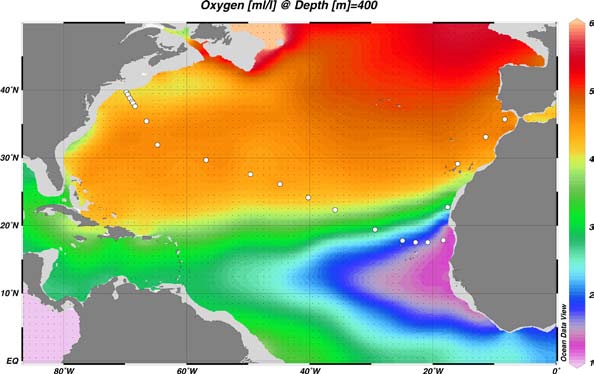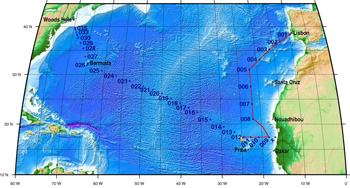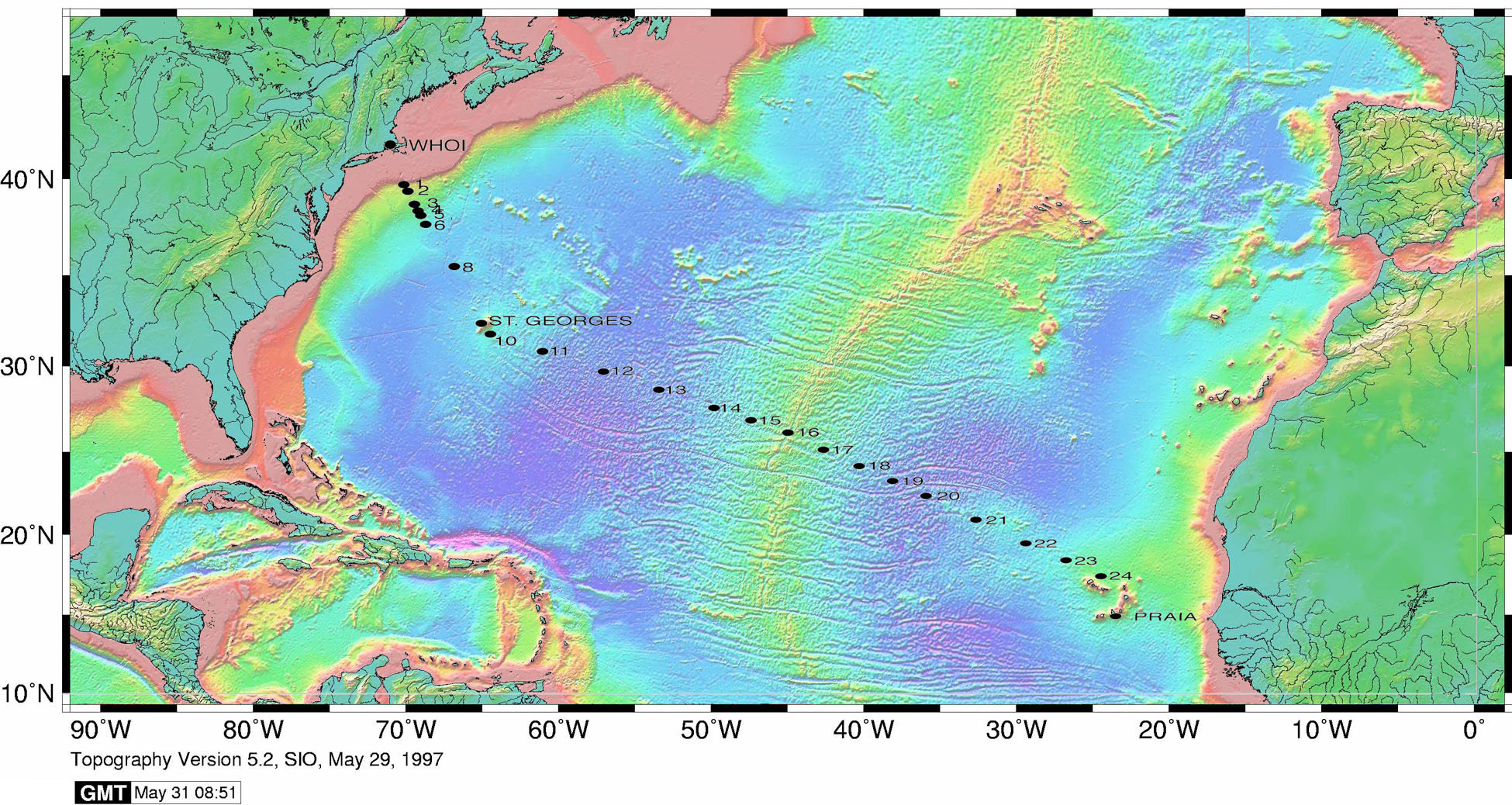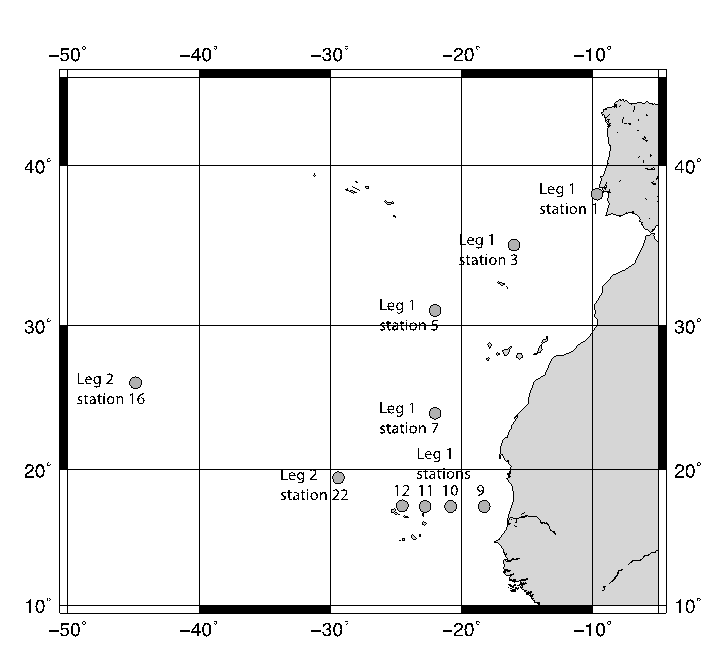Seawater Nd isotopes and concentrations from the US-GEOTRACES North Atlantic zonal transect (NAZT), 2010 and 2011 on cruises KN199-04 and KN204-01, analyzed at LDEO
Project
Program
| Contributors | Affiliation | Role |
|---|---|---|
| Goldstein, Steven L. | Lamont-Doherty Earth Observatory (LDEO) | Principal Investigator |
| Pahnke, Katharina | University of Hawai'i (UH) | Principal Investigator |
| Scher, Howard | University of South Carolina | Principal Investigator |
| Pena, Leopoldo D. | Lamont-Doherty Earth Observatory (LDEO) | Scientist |
| Stichel, Torben | University of Hawaiʻi at Mānoa (SOEST) | Scientist |
| Duggan, Brian | University of South Carolina | Student |
| Hartman, Alison | Lamont-Doherty Earth Observatory (LDEO) | Student |
| Copley, Nancy | Woods Hole Oceanographic Institution (WHOI BCO-DMO) | BCO-DMO Data Manager |
Abstract
Methodology: A detailed description can be found in Stichel et al. (2015). See the links below for summaries of the described methodology from the paper.
KN199-04 Methodology (pdf)
KN204-01 Methodology (pdf)
Fig. 1: Sample locations for the Intermediate Data Product.
References: (References listed in the data are codes [1], [2], or [3], corresponding with the following publications/manuscripts)
[1] Stichel, T., Hartman, A.E., Duggan, B., Goldstein, S.L., Scher, H., Pahnke, K., 2015. Separating biogeochemical cycling of neodymium from water mass mixing in the Eastern North Atlantic. Earth Planet. Sci. Lett. 412, 245–260. doi:10.1016/j.epsl.2014.12.008
[2] Hartman, A., Goldstein, S., Pena Gonzalez, L. D., Duggan, B., Pahnke, K., Scher, H., Stichel, T., in prep. Seawater neodymium composition in the open ocean North Atlantic: water mass signatures and transport.
[3] Duggan, B., Hartman, A.E., Stichel, T., Goldstein, S.L., Pahnke, K., Bizimis, M., Scher, H., in prep. Neodymium Concentrations and Isotopic Signature of the Deep Western Boundary Current Across Line W
Table 1: Summary of the procedures applied in the involved laboratories of University of Hawaii at Mano (UH), Lamont-Doherty Earth Observatory (LDEO) and University of South Carolina (USC).
|
Step |
UH |
LDEO |
USC |
|
Pre-concentration |
Spiked with 146Nd prior to co-precipitation with FeOOH (~20mg Fe per sample) |
Spiked with 150Nd prior to co-precipitation with FeOOH (~20mg Fe per sample) |
Nd and REE extraction with C18 cartridges, not spiked |
|
Chromatographic separation |
2-step separation: |
2-step separation: |
1-step separation: |
|
Mass spectrometry |
VG-Sector TIMS, NdO+, spiked for simultaneous isotope dilution and composition analysis |
VG-Sector54 TIMS, NdO+, spiked for simultaneous isotope dilution and composition analysis |
Thermo Neptune Plus MC-ICPMS |
|
Other |
Concentrations were determined on a previously separated 500ml aliquot by isotope dilution |
Data Processing:
The measured 143Nd/144Nd isotope ratios were normalized to those of the JNdi-1 Nd standard (0.512115, Tanaka et al., 2000). Please see attached methodology files for further information on the data processing.
BCO-DMO Processing Notes:
- Added the sample_GEOTRC column by copying the original sample column and removing the '_2' from sample duplicates.
- Added Cast_ISO_DateTime_UTC from the original date and time fields.
SUMMARY OF CORRECTIONS MADE TO SUBMITTED DATA:
2017-07-17: parameter descriptions revised as per request by R. Anderson: ND_143_ND_144RATIO and int_ND_143_ND_144RATIO.
version 8: The data for version 8 (April 2016) completely replaced those from version 7.
- The quality flag scheme was changed in accordance with ODV.
- New parameters: EPSILON_Nd, EPSILON_ND_FLAG_W, EPSILON_ND_2SD, Instrument, and Reference were added which are described in the documentation.
- Column cruise_part was removed.
- Version 8b: changed quality flags for KN204-01, stations 3 and 8 from 0 to 2
- 07 March 2013: Made the following corrections after consulting with dataset scientist:
KN199-04
-- Changed cast number of event 3176 from 2 to 8.
-- Changed cast number of event 3169 from 8 to 2.
-- Changed event number of KN199-04 station 3 cast 6 from 2059 to 2061.
-- Changed event number of KN199-04 station 7 cast 6 from 2107 to 2132.
-- Changed event number of KN199-04 station 9 cast 3 from 2059 to 2165.
-- Changed event number of KN199-04 station 10 cast 6 from 2191 to 2194.
-- Changed event number of KN199-04 station 11 cast 6 from 2206 to 2208.
-- Changed bottle number of sample #5393 from 5 to 4 (station 5, cast 6).
-- Changed bottle number of sample #5394 from 4 to 3 (station 5, cast 6).
-- Changed time of event #2024 from 2129 to 1202.
KN204-01
-- Changed bottle number of sample #7955 from 8 to 9 (station 22, cast 4).
Additional data and revisions were served 19 Sept. 2013.
version 9: The original dataset was split into three datasets by LAB. LDEO, UH, and USC.
See UH dataset: https://www.bco-dmo.org/dataset/780664
USC dataset: https://www.bco-dmo.org/dataset/3832
Additional GEOTRACES Processing:
After the data were submitted to the International Data Management Office, BODC, the office noticed that important identifying information was missing in many datasets. With the agreement of BODC and the US GEOTRACES lead PIs, BCO-DMO added standard US GEOTRACES information, such as the US GEOTRACES event number, to each submitted dataset lacking this information. To accomplish this, BCO-DMO compiled a 'master' dataset composed of the following parameters: station_GEOTRC, cast_GEOTRC (bottle and pump data only), event_GEOTRC, sample_GEOTRC, sample_bottle_GEOTRC (bottle data only), bottle_GEOTRC (bottle data only), depth_GEOTRC_CTD (bottle data only), depth_GEOTRC_CTD_rounded (bottle data only), BTL_ISO_DateTime_UTC (bottle data only), and GeoFish_id (GeoFish data only). This added information will facilitate subsequent analysis and inter comparison of the datasets.
Bottle parameters in the master file were taken from the GT-C_Bottle_GT10, GT-C_Bottle_GT11, ODF_Bottle_GT10, and ODF_Bottle_GT11 datasets. Non-bottle parameters, including those from GeoFish tows, Aerosol sampling, and McLane Pumps, were taken from the Event_Log_GT10 and Event_Log_GT11 datasets. McLane pump cast numbers missing in event logs were taken from the Particulate Th-234 dataset submitted by Ken Buesseler.
A standardized BCO-DMO method (called "join") was then used to merge the missing parameters to each US GEOTRACES dataset, most often by matching on sample_GEOTRC or on some unique combination of other parameters.
If the master parameters were included in the original data file and the values did not differ from the master file, the original data columns were retained and the names of the parameters were changed from the PI-submitted names to the standardized master names. If there were differences between the PI-supplied parameter values and those in the master file, both columns were retained. If the original data submission included all of the master parameters, no additional columns were added, but parameter names were modified to match the naming conventions of the master file.
See the dataset parameters documentation for a description of which parameters were supplied by the PI and which were added via the join method.
| File |
|---|
Nd_GT10-11_v8b_joined.csv (Comma Separated Values (.csv), 22.88 KB) MD5:fcdf978f8608b47cc7fffb9ea82b7596 Primary data file for dataset ID 780582 |
| File |
|---|
KN199-4 DATASET description Metadata for GDAC filename: data_desc_GDAC_Stichel_199-04.pdf (Portable Document Format (.pdf), 453.72 KB) MD5:1030eae374b4abdb421b8524491025c7 KN199-4 DATASET description Metadata for GDAC |
KN204-1 DATASET description Metadata for GDAC filename: data_desc_GDAC_Stichel_204-01.pdf (Portable Document Format (.pdf), 442.37 KB) MD5:877f9c034458c9b0fee6d13699484a66 KN204-1 DATASET description Metadata for GDAC |
| Parameter | Description | Units |
| cruise_id | Official cruise identifier | unitless |
| cruise_name | agreed nomenclature on cruise section during ODU-GEOTRACES workshop in March 2013 | unitless |
| station_GEOTRC | station number; provided in original data submission | unitless |
| depth_ctd | sampling depth of CTD; also added are depths of surface sampled by GeoFish. Values provided by PI. | meters |
| depth_GEOTRC_CTD_round | sampling depth rounded to nearest meter | meters |
| cast_GEOTRC | cast number | unitless |
| event_GEOTRC | event number; provided in original data submission | unitless |
| date | date of cast; UTC | yyyymmdd |
| time | time of collection; UTC | HHMM |
| sample_bottle_GEOTRC | Unique identification numbers given to samples taken from bottles; ranges from 1 to 24; often used synonymously with bottle number. nd bottles were from surface GeoFish. Values were added from the intermediate US GEOTRACES master file (see Processing Description). | unitless |
| BTL_ISO_DateTime_UTC | Date and time (UTC) variable recorded at the bottle sampling time in ISO compliant format. Values were added from the intermediate US GEOTRACES master file (see Processing Description). | YYYY-MM-DDTHH:MM:SS[.xx][+/-TZ] |
| lat | latitude; North is positive.Values were added from the intermediate US GEOTRACES master file (see Processing Description). | decimal degrees |
| lon | longitude; East is positive.Values were added from the intermediate US GEOTRACES master file (see Processing Description). | decimal degrees |
| sample_GEOTRC | GEOTRACES sample number; provided in original data submission. Values were added from the intermediate US GEOTRACES master file (see Processing Description) and match those provided by PI. | unitless |
| ND_143_ND_144RATIO | Final atom ratio of 143Nd/144Nd after correcting mass bias and instrumental offset | unitless |
| ND_143_ND_144_FLAG_W | Quality flag: Flag 0: good value; Flag 1: no value or unknown value; Flag 2: replacement considered good value; Flag 4: not trusted; -999: missing value | unitless |
| int_ND_143_ND_144RATIO | Standard error of the mean using standard deviation divided by the square root of ratios in one measurement (e.g. UH used normally 378 ratios for one measurement) | unitless |
| EPSILON_Nd | final 143Nd/144Nd normalized to 0.512638 (143Nd1/44Nd of the Chondritic Uniform Reservoir in Jacobsen and Wasserburg - 1980) in parts per 10000. | parts per 10000 |
| EPSILON_ND_FLAG_W | Quality flag: Flag 0: good value; Flag 1: no value or unknown value; Flag 2: replacement considered good value; Flag 4: not trusted; -999: missing value | unitless |
| EPSILON_ND_2SD | 2 standard deviations of the repeatedly measured standards during the analysis | parts per 10000 |
| diss_Nd_pmol_kg | dissolved Nd concentration | pmol/kg |
| REE_ND_UH_FLAG_W | Quality flag: Flag 0: good value; Flag 1: no value or unknown value; Flag 2: replacement considered good value; Flag 4: not trusted; -999: missing value | unitless |
| LAB | the lab group that analyzed the sample: LDEO = Lamont-Doherty Earth Observatory: UH = Univ. of Hawaii; USC = Univ. of South Carolina | unitless |
| Instrument | instrument used for analysis: TIMS: Thermal ionization mass spectrometer (VG-Sector (UH) or VG-Sector54 (LDEO)); ICPMS: Multi-Collector Inductively Coupled Mass Spectrometer (NeptunePlus) | unitless |
| Reference | Publication reference; see Description for details | unitless |
| Dataset-specific Instrument Name | CTD Sea-Bird |
| Generic Instrument Name | CTD Sea-Bird |
| Dataset-specific Description | SeaBird CTD, oxygen, fluorescence and transmissometer sensors were attached to the frame in stainless steel or anodized aluminum housings. |
| Generic Instrument Description | A Conductivity, Temperature, Depth (CTD) sensor package from SeaBird Electronics. This instrument designation is used when specific make and model are not known or when a more specific term is not available in the BCO-DMO vocabulary. Refer to the dataset-specific metadata for more information about the specific CTD used. More information from: http://www.seabird.com/ |
| Dataset-specific Instrument Name | GeoFish |
| Generic Instrument Name | GeoFish Towed near-Surface Sampler |
| Generic Instrument Description | The GeoFish towed sampler is a custom designed near surface ( |
| Dataset-specific Instrument Name | Mass Spectrometer |
| Generic Instrument Name | Mass Spectrometer |
| Dataset-specific Description | Neodymium was measured as NdO+ on a VG TIMS Sector ( at UH) and VG TIMS Sector54 ( at LDEO). At USC, the Nd isotope composition was measured on a Thermo Neptune Plus MC-ICPMS. |
| Generic Instrument Description | General term for instruments used to measure the mass-to-charge ratio of ions; generally used to find the composition of a sample by generating a mass spectrum representing the masses of sample components. |
| Dataset-specific Instrument Name | Niskin bottle |
| Generic Instrument Name | Niskin bottle |
| Dataset-specific Description | 30L Niskin bottles with Nylon-coated internal stainless steel springs and Viton o-rings, mounted on a powder-coated aluminum frame. |
| Generic Instrument Description | A Niskin bottle (a next generation water sampler based on the Nansen bottle) is a cylindrical, non-metallic water collection device with stoppers at both ends. The bottles can be attached individually on a hydrowire or deployed in 12, 24, or 36 bottle Rosette systems mounted on a frame and combined with a CTD. Niskin bottles are used to collect discrete water samples for a range of measurements including pigments, nutrients, plankton, etc. |
KN204-01
| Website | |
| Platform | R/V Knorr |
| Report | |
| Start Date | 2011-11-06 |
| End Date | 2011-12-11 |
| Description | The US GEOTRACES North Atlantic cruise aboard the R/V Knorr completed the section between Lisbon and Woods Hole that began in October 2010 but was rescheduled for November-December 2011. The R/V Knorr made a brief stop in Bermuda to exchange samples and personnel before continuing across the basin. Scientists disembarked in Praia, Cape Verde, on 11 December. The cruise was identified as KN204-01A (first part before Bermuda) and KN204-01B (after the Bermuda stop). However, the official deployment name for this cruise is KN204-01 and includes both part A and B.
Science activities included: ODF 30 liter rosette CTD casts, ODU Trace metal rosette CTD casts, McLane particulate pump casts, underway sampling with towed fish and sampling from the shipboard "uncontaminated" flow-through system.
Full depth stations are shown in the accompanying figure (see below). Additional stations to sample for selected trace metals to a depth of 1000 m are not shown. Standard stations are shown in red (as are the ports) and "super" stations, with extra casts to provide large-volume samples for selected parameters, are shown in green.
Station spacing is concentrated along the western margin to evaluate the transport of trace elements and isotopes by western boundary currents. Stations across the gyre will allow scientists to examine trace element supply by Saharan dust, while also contrasting trace element and isotope distributions in the oligotrophic gyre with conditions near biologically productive ocean margins, both in the west, to be sampled now, and within the eastern boundary upwelling system off Mauritania, sampled last year.
Funding: The cruise was funded by NSF OCE awards 0926204, 0926433 and 0926659.
Additional cruise information is available from the Rolling Deck to Repository (R2R): https://www.rvdata.us/search/cruise/KN204-01
Other Relevant Links:
ADCP data are available from the Currents ADCP group at the University of Hawaii at the links below:
KN204-01A (part 1 of 2011 cruise; Woods Hole, MA to Bermuda)
KN204-01B (part 2 of 2011 cruise; Bermuda to Cape Verde) |
KN199-04
| Website | |
| Platform | R/V Knorr |
| Report | |
| Start Date | 2010-10-15 |
| End Date | 2010-11-04 |
| Description | This cruise constitutes the first survey section as part of the U.S. participation in an international program named GEOTRACES.
Funding: NSF OCE award 0926423
Science Objectives: To obtain state of the art trace metal and isotope measurements on a suite of samples taken on a mid-latitude zonal transect of the North Atlantic. In particular, sampling targeted the oxygen minimum zone extending off the west African coast near Mauritania, the TAG hydrothermal field, and the western boundary current system along Line W. For additional information, please refer to the GEOTRACES program Web site (https://www.geotraces.org/) for overall program objectives and a summary of properties measured.
Science Activities include seawater sampling via GoFLO and Niskin carousels, in situ pumping (and filtration), CTDO2 and transmissometer sensors, underway pumped sampling of surface waters, and collection of aerosols and rain. Hydrography, CTD and nutrient measurements were supported by the Ocean Data Facility (J. Swift) at Scripps Institution of Oceanography and funded through NSF Facilities. They provided an additional CTD rosette system along with nephelometer and LADCP. A trace metal clean Go-Flo Rosette and winch were provided by the group at Old Dominion University (G. Cutter) along with a towed underway pumping system.
Additional cruise information is available from the Rolling Deck to Repository (R2R): https://www.rvdata.us/search/cruise/KN199-04
Other Relevant Links:
List of cruise participants: [ PDF ]
Cruise track: JPEG image (from Woods Hole Oceanographic Institution, vessel operator)
ADCP data are available from the Currents ADCP group at the University of Hawaii: KN199-04 ADCP |
U.S. GEOTRACES North Atlantic Transect (GA03) (U.S. GEOTRACES NAT)
Much of this text appeared in an article published in OCB News, October 2008, by the OCB Project Office.
The first U.S. GEOTRACES Atlantic Section will be specifically centered around a sampling cruise to be carried out in the North Atlantic in 2010. Ed Boyle (MIT) and Bill Jenkins (WHOI) organized a three-day planning workshop that was held September 22-24, 2008 at the Woods Hole Oceanographic Institution. The main goal of the workshop, sponsored by the National Science Foundation and the U.S. GEOTRACES Scientific Steering Committee, was to design the implementation plan for the first U.S. GEOTRACES Atlantic Section. The primary cruise design motivation was to improve knowledge of the sources, sinks and internal cycling of Trace Elements and their Isotopes (TEIs) by studying their distributions along a section in the North Atlantic (Figure 1). The North Atlantic has the full suite of processes that affect TEIs, including strong meridional advection, boundary scavenging and source effects, aeolian deposition, and the salty Mediterranean Outflow. The North Atlantic is particularly important as it lies at the "origin" of the global Meridional Overturning Circulation.
It is well understood that many trace metals play important roles in biogeochemical processes and the carbon cycle, yet very little is known about their large-scale distributions and the regional scale processes that affect them. Recent advances in sampling and analytical techniques, along with advances in our understanding of their roles in enzymatic and catalytic processes in the open ocean provide a natural opportunity to make substantial advances in our understanding of these important elements. Moreover, we are motivated by the prospect of global change and the need to understand the present and future workings of the ocean's biogeochemistry. The GEOTRACES strategy is to measure a broad suite of TEIs to constrain the critical biogeochemical processes that influence their distributions. In addition to these "exotic" substances, more traditional properties, including macronutrients (at micromolar and nanomolar levels), CTD, bio-optical parameters, and carbon system characteristics will be measured. The cruise starts at Line W, a repeat hydrographic section southeast of Cape Cod, extends to Bermuda and subsequently through the North Atlantic oligotrophic subtropical gyre, then transects into the African coast in the northern limb of the coastal upwelling region. From there, the cruise goes northward into the Mediterranean outflow. The station locations shown on the map are for the "fulldepth TEI" stations, and constitute approximately half of the stations to be ultimately occupied.
Figure 1. The proposed 2010 Atlantic GEOTRACES cruise track plotted on dissolved oxygen at 400 m depth. Data from the World Ocean Atlas (Levitus et al., 2005) were plotted using Ocean Data View (courtesy Reiner Schlitzer). [click on the image to view a larger version]

Hydrography, CTD and nutrient measurements will be supported by the Ocean Data Facility (J. Swift) at Scripps Institution of Oceanography and funded through NSF Facilities. They will be providing an additional CTD rosette system along with nephelometer and LADCP. A trace metal clean Go-Flo Rosette and winch will be provided by the group at Old Dominion University (G. Cutter) along with a towed underway pumping system.
The North Atlantic Transect cruise began in 2010 with KN199 leg 4 (station sampling) and leg 5 (underway sampling only) (Figure 2).
Figure 2. The red line shows the cruise track for the first leg of the US Geotraces North Atlantic Transect on the R/V Knorr in October 2010. The rest of the stations (beginning with 13) will be completed in October-December 2011 on the R/V Knorr (courtesy of Bill Jenkins, Chief Scientist, GNAT first leg). [click on the image to view a larger version]

The section completion effort resumed again in November 2011 with KN204-01A,B (Figure 3).
KN204-01A,B Cruise Report (PDF)
Figure 3. Station locations occupied on the US Geotraces North Atlantic Transect on the R/V Knorr in November 2011. [click on the image to view a larger version]

Data from the North Atlantic Transect cruises are available under the Datasets heading below, and consensus values for the SAFe and North Atlantic GEOTRACES Reference Seawater Samples are available from the GEOTRACES Program Office: Standards and Reference Materials
ADCP data are available from the Currents ADCP group at the University of Hawaii at the links below:
KN199-04 (leg 1 of 2010 cruise; Lisbon to Cape Verde)
KN199-05 (leg 2 of 2010 cruise; Cape Verde to Charleston, NC)
KN204-01A (part 1 of 2011 cruise; Woods Hole, MA to Bermuda)
KN204-01B (part 2 of 2011 cruise; Bermuda to Cape Verde)
U.S. GEOTRACES (U.S. GEOTRACES)
GEOTRACES is a SCOR sponsored program; and funding for program infrastructure development is provided by the U.S. National Science Foundation.
GEOTRACES gained momentum following a special symposium, S02: Biogeochemical cycling of trace elements and isotopes in the ocean and applications to constrain contemporary marine processes (GEOSECS II), at a 2003 Goldschmidt meeting convened in Japan. The GEOSECS II acronym referred to the Geochemical Ocean Section Studies To determine full water column distributions of selected trace elements and isotopes, including their concentration, chemical speciation, and physical form, along a sufficient number of sections in each ocean basin to establish the principal relationships between these distributions and with more traditional hydrographic parameters;
* To evaluate the sources, sinks, and internal cycling of these species and thereby characterize more completely the physical, chemical and biological processes regulating their distributions, and the sensitivity of these processes to global change; and
* To understand the processes that control the concentrations of geochemical species used for proxies of the past environment, both in the water column and in the substrates that reflect the water column.
GEOTRACES will be global in scope, consisting of ocean sections complemented by regional process studies. Sections and process studies will combine fieldwork, laboratory experiments and modelling. Beyond realizing the scientific objectives identified above, a natural outcome of this work will be to build a community of marine scientists who understand the processes regulating trace element cycles sufficiently well to exploit this knowledge reliably in future interdisciplinary studies.
Expand "Projects" below for information about and data resulting from individual US GEOTRACES research projects.
| Funding Source | Award |
|---|---|
| NSF Division of Ocean Sciences (NSF OCE) | |
| NSF Division of Ocean Sciences (NSF OCE) | |
| NSF Division of Ocean Sciences (NSF OCE) |
[ table of contents | back to top ]
